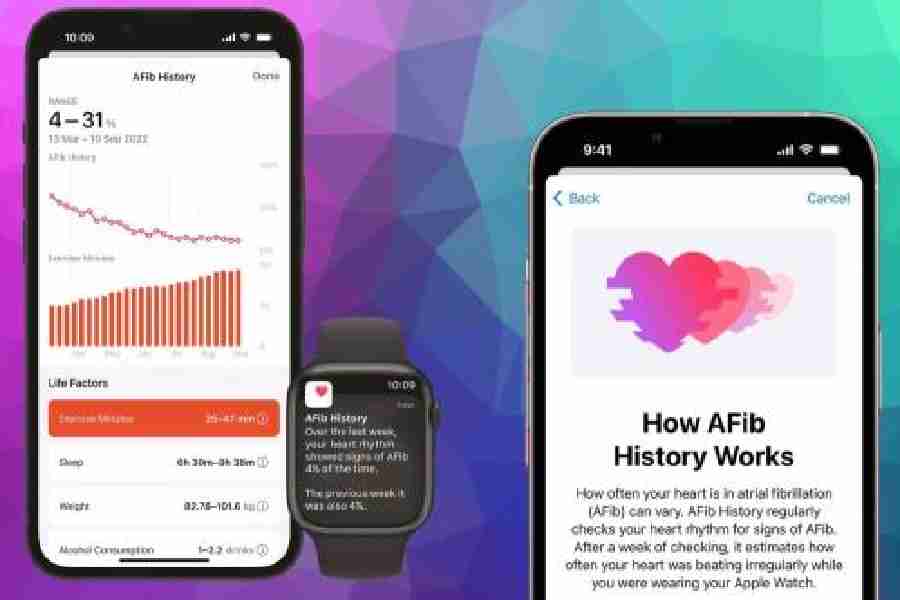Whatever the road to your fitness goals — be it through running, walking, swimming or hiking — the Apple Watch has fitness and health features for everyone. More importantly, there are features that point you in the right direction when it comes to getting help from a doctor. That brings us to AFib History, which is now available in India on Apple Watch Series 4 (and later) for users on watchOS 9.
Atrial fibrillation (AFib) is a type of irregular heart rhythm where the upper chambers of the heart beat out of sync with the lower chambers. Going by Centers for Disease Control and Prevention (CDC) figures, around two per cent of people younger than 65 years old and nine per cent of people 65 and older have AFib. Some individuals with AFib don’t even experience any symptoms. Others may experience symptoms that could include rapid heartbeat, palpitations, fatigue, or shortness of breath. It’s important to remember that people with AFib often live healthy, active lives and the amount of time your heart is in AFib can be reduced with regular exercise, a heart-healthy diet and treatment of other medical conditions that could worsen AFib.
What AFib History offers is long-term visibility into the amount of time your heart shows signs of AFib, so you can share this information with your physician. On the Apple Watch is the ECG app and irregular rhythm notification, which can identify potential signs of AFib. For those already diagnosed with AFib, AFib History is a first-of-its-kind feature that can track the amount of time your heart is in AFib and also support management of important lifestyle factors.
The feature offers a weekly estimate of the amount of time your heart shows signs of AFib, also known as AFib burden. There is a chance of AFib occurring any time but there are factors that may impact the percentage of time your heart shows signs of AFib. AFib History helps manage the following life factors that can impact the percentage your heart is in AFib — exercise minutes, sleep, weight, alcohol consumption and mindful minutes.
How to set up AFib history
To set up the feature, first update to the latest version of iOS and watchOS, and then load the Health app on the iPhone paired with an Apple Watch. Tap the ‘Browse’ tab at the bottom of the screen, and then select the ‘Heart’ category. Tap the ‘AFib History’ tab in the list. Once you go through how AFib History works, move to the next step by tapping the blue ‘Set Up’ button. Tap ‘continue’ to learn more about AFib History, the results, and life factors And that’s it. AFib History is not intended for use by people under 22 years old.
AFib History estimate
You need to give the Apple Watch enough time to gather readings. Once done, every Monday users receive weekly alerts on the Apple Watch with the estimated percentage of time their heart showed signs of AFib from the previous week. You can also view their history in greater detail in the Health app. AFib History estimate appears as a percentage. A lower percentage means your heart was in AFib less often, while a higher percentage means more often. AFib History will never show as zero per cent. Instead, it will show as “2% or less”. Users can also tap Show Life Factors to compare a Life Factor with AFib History.
AFib History Highlights show the day of week and time of day the heart is most frequently showing signs of AFib. This can help assess how life factors could be impacting their condition. After gathering enough readings, AFib History Highlights are available after six weeks of wearing Apple Watch.
But remember….
You must have a physician diagnosis of AFib. Also, one needs to wear the Apple Watch at least 12 hours a day for five days a week to consistently receive estimates. Remember to enable Heart Rate and Wrist Detection. Keep in mind that Low Power Mode will turn off background heart measurements and may lead to no AFib History estimates if enabled. Most importantly, the Apple Watch cannot detect a heart attack or stroke.
Share your History...
You can also export AFib History data to a PDF to share with a physician.
